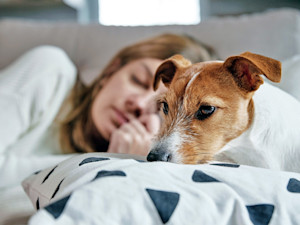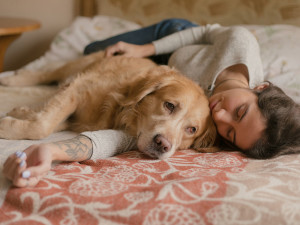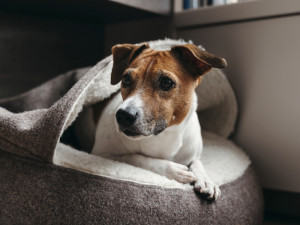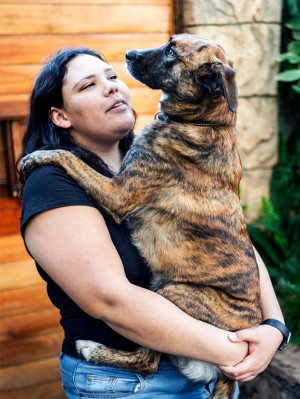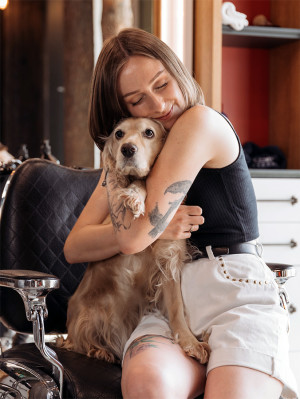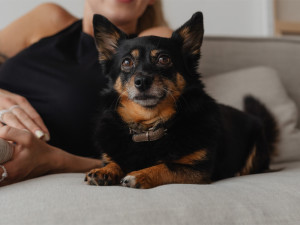Can Dogs Have Panic Attacks, Too?
How to tell if your dog is super stressed.
I woke up at 3 in the morning to someone staring at me. My senior rescue dog sat on the bed, shaking.
I turned on a light and tried to soothe her with pets, but it didn’t help. Her panting was as loud as a lawnmower, and her wide eyes looked like she was having a showdown with a ghost. After about 45 minutes, she hopped down her pet stairs to use her “emergency” wee-wee pads in the other room. It’s rare she uses them, but that night, it looked like we lived with a pack; they were completely covered in runny poop.
Trick question: All dogs are perfect! But find out which type is the best fit for you.
I called her vet’s office at 4 in the morning to ask the overnight nurse if she thought the shaking, panting, and stomach issues were an emergency. As long as my dog hadn’t eaten anything suspicious or poisonous, she said we could wait until morning to schedule an appointment.
By morning, though, my 10-year-old dog, Claude, was back to normal: tail wagging on her walk, happily eating her breakfast, no upset stomach at all. But when her overnight anxiety spiked two more times, I took Claude to see her vet, who confirmed what I suspected: Claude was having panic attacks (yes, this does happen).
How much do you spend on your pet per year?
Signs and symptoms
A dog having a panic attack is dealing with “a toxic level of stress,” Gabrielle Johnson, certified dog behavior consultant, of Best Life Dog Servicesopens in new tab, tells me.
“It can be really scary, because you don’t know what’s going on, and you’re just looking at your dog who’s shaking and panting and staring at you,” Johnson says. “Dogs in that state will have difficulty processing information, smells, sights, sounds. They’re going to have difficulty responding to known cues, which can include things like their name.”
In most of these situations, your pup is not actually unsafe, but they believe they are. Physiologically, that may result in your dog:
Drooling
Shaking
Running around restlessly
Pacing
Panting
Whining or howling
Hiding or trying to escape a room
Clinging to you for attention (when that’s not their normal vibe)
Peeing in the house
Having diarrhea
“It can go on for hours; it can be a few minutes,” Johnson says. “It really depends.”
What causes panic attacks in dogs?
I’ve had panic attacks myself, and I know that I have at least one trigger, but they can also happen out of the blue. A dog’s experience is pretty similar.
In Claude’s case, it’s still a bit of a mystery, but Johnson tells me that dogs who already have a lot of anxiety — as Claude does — could be more likely to have panic attacks. I don’t know much about the first eight years of Claude’s life (before she came to live with me), but sadly, all signs point to it not being so great.
“A dog who has a generalized anxiety disorder is up against a bit more, versus a dog who’s generally relaxed,” Johnson says. “They might have more coping skills. They might bounce back faster.”
But there are also a lot of triggers that can affect any dog:
Noise
One study of more than 13,000 dogs found that noise sensitivity is the most common canine anxiety traitopens in new tab; nearly one-third of pups in the study were scared of at least one noise. Unfortunately, living in a big city with lots of noise could also contribute to panic attacks, Dr. Katie Bodkin, a veterinarian at Westside Veterinary Centeropens in new tab in New York City says. There are sirens, noisy neighbors, and (Claude’s nemesis) street sweepers. “It’s totally different in New York City than a dog in the country with a backyard,” Dr. Bodkin adds.
Claude and I aren’t ready to depart for upstate just yet, so I’m grateful there are options for managing her anxiety. (After all, if a pup can make it here, they can make it anywhere — right?) But even rural and suburban dogs get the jitters: There are obvious triggers, like fireworks or thunderstorms, but an unexpected household noise (like the buzz of an appliance or the ringing of a phone) could also cause a panic attack. Some sounds can even be painful for dogsopens in new tab — think high-frequency ones — so it’s important to minimize the noise if that’s the trigger.
Separation anxiety
Dr. Bodkin says that she’s seen a lot more anxious dogs after people started returning to the office post-pandemic. Doggy daycare or a sitteropens in new tab may be a good salve for some dogs, but it’s not a fit for everyone, depending on location, budget, and how your pup gets along with friends. (The last thing you want is for it to backfire and make them more nervous.)
Caryn Self Sullivan, who has a PhD in animal behavior and runs Beach Paws Boutique in Colonial Beach, Virginia, says that most of the panic attacks she sees in dogs are due to separation anxietyopens in new tab.
“If you’re walking your dog, and they’re afraid of other dogs, or they’re afraid of certain sounds, generally… you can get your dog out of that situation pretty quickly,” Sullivan says. “The reason I think we see it so much in separation anxiety is because nobody’s watching the dog. Nobody sees what’s going on.”
That’s why she recommends in-home cameras for all her clients; together, they try to piece together the dog’s “time threshold,” or how long until the panic attack starts. She then works with clients to “build” that time.
“I’ve started people on not even leaving the house, just going to the door and pretending like they’re going to leave and coming back, until the dog will tolerate that without starting to get upset,” Sullivan says, adding that treatment varies and can require different exercises and reassessments. “Basically, we’re teaching the dog it’s safe to be alone. They don’t have to panic.”
PTSD
“The other thing we don’t have a lot of good information on is PTSD in dogs,” Johnson says, explaining that our human diagnostic tools don’t work with dogs. “For example, we can’t ask dogs if they have nightmares. But it is definitely, I suspect, probably underdiagnosed.”
Pain
Imagine having a scary pain — like a muscle cramp — and not understanding what it is. “[A trigger] could be something physiological,” Sullivan says. In some cases, a dog’s reaction to that pain could cause their anxiety to ramp into overdrive and cause a panic attack.
Other causes
Sometimes, it’s just a medical mystery.
“It could be a smell; their sense of smell is so much better than ours,” Johnson says. “Sometimes we’re just not perceiving [the trigger]. The trigger is there. It’s tangible. But we don’t know what it is.” A vet visit or confinement could also trigger an attack. A bad dream is another possibility, Sullivan adds, as are other nighttime stressorsopens in new tab.
Research also suggests a possible link between gut health and anxiety opens in new tab in dogs; the gut-brain relationship is already well-established in humans.
Diagnosis and treatment
According to Dr. Bodkin, it’s important to rule out physical causes before diagnosing a dog with anxiety or, more specifically, panic attacks. She says it can also be helpful for pet parents to bring documentation, such as a video, so that a vet can see exactly what’s going on.
Medicine
Once your vet has ruled out anything physical, they might prescribe anti-anxiety medicationopens in new tab, like Dr. Bodkin did for Claude. Claude takes Trazodone (an antidepressant with sedative properties) as well as Clomicalm (often referred to as “doggie Prozac” — dogs, they’re just like us!).
Common medications include:
Trazodone
Clomicalm (clomipramine)
Reconcile (fluoxetine)
Sileo (a gel specifically for noise aversion)
Human medications that may be used off-label
“Medication can play a huge role,” Johnson says, explaining that it’s ideal if you know what your dog’s trigger is and can administer any sedating medications ahead of time. “We can lessen the damage done by the panic attack, and we might see them bounce back faster.”
In more severe cases, medications may be taken daily, as in Claude’s case. For other dogs, it might be a temporary solution while they work on behavior modification.
Behavior modification
Depending on your pup’s situation, your vet may also recommend a certified trainer, behavior expert, or veterinary behaviorist who can help your dog reduce their fear.
The goal is to decrease the dog’s physiological response to the stressor, to increase their ability to self-regulate, and to boost their resilience, so that they’re bouncing back from the panic attack faster with less and less support from their pet parent, Johnson adds.
“They’re taking a few minutes to self-regulate, instead of it potentially ruining their day or week or even month,” Johnson says. “So, we’re finding ways to increase the dog’s ability to have control, or to perceive that they have control over their life. “We’re also doing things to change emotional responses. A really simple example would be, ‘Oh, [the sound of] fireworks actually equal [the sound of] popcorn [in the dog’s mind], not death,’ you know? So, you work to change that.”
It’s important to find a trainer who uses positive reinforcement (no yelling or shock collars, for example) methods, who you feel comfortable with, and who has the proper degree or certification.
Can you help prevent a panic attack in dogs?
If your dog has a known trigger, the easiest way to avoid a panic attack is to take steps to avoid that trigger. But that’s not always practical — or possible (for example, you can’t control a thunderstorm). Having medications on hand to take before the event is a good way to lessen the chance of your pup panicking.
How to help a dog with panic attacks
Provide comfort
It’s a wild world we live in, and there’s nothing better than compassion. Put yourself in your dog’s shoes — erm, booties. Your dog is just as confused and scared as you would be if you were having a panic attack.
Take a moment to collect yourself, then offer supportopens in new tab. Petting, hugging, or brushing your dog is fine, as long as touch is not a trigger.
Avoid punishing
How could you be angry when your bestie is terrified? What’s more, it will get you nowhere. “[Dogs] don’t understand why you’re yelling at them,” Dr. Bodkin says. “They learn much more through positive reinforcement.”
Stick to a routine
Sticking to a routine at home can help a dog feel more in controlopens in new tab, thereby lessening their anxiety. Claude has the same routine every single day, and knowing what to expect helps keep her anxiety in check.
Along with medication, a routine has really helped her anxiety, and she hasn’t had a panic attack in months.
More exercise… or less
Dr. Bodkin says that in New York City, she often sees dogs who need more exercise. On the other hand, Sullivan says some dogs get too much stimulation. A trained professional can evaluate which camp, if either, your dog falls into.
Offer a safe space
Many dogs feel safe in a crate that they are free to come and go in, Dr. Bodkin says. Claude has multiple “tent beds” around the apartment so that she can hide away whenever she wants. It’s important that your dog doesn’t feel confined, which can worsen their anxiety.
Mental stimulation
Mental stimulation has been shown to help ease dogs’ anxietyopens in new tab, so make sure your dog has plenty of toys, puzzles, and other fun stuff to keep them entertained.
Supplements
Before you take the medication route, there’s nothing wrong with trying out some supplements (although it’s a smart idea to run these by your vet before experimenting with them).
Supplements come in chews, tablets, capsules, or liquids. Some common ingredients include:
L-theanine
Melatonin
Chamomile
Valerian root
L-tryptophan
L-theanine
CBD
Dogs also respond strongly to scents, and one study shows that lavender and chamomileopens in new tab have soothing effects. You can buy a lavender spray, for example, to spritz when your dog is feeling anxious.
What conditions can mimic a panic attack?
According to Dr. Bodkin, it’s important to rule out conditions such as epilepsy, high blood pressure, or even (in very rare cases) a brain tumor, to make sure there’s not a physiological reason behind your dog’s anxiety. Your vet will also look for thyroid or adrenal issues.
When to seek professional help
The first time you notice the signs of a panic attack in your dog, call your vet to see what they recommend. A panic attack doesn’t necessarily happen just once and then go away, so the sooner you try to lessen their frequency, the better. How long does treatment normally take? “I tell people to think in terms of months, not weeks or years,” Sullivan says.
One of the biggest mistakes we can make is not reading our dog’s body language, she adds. “Most people don’t think of them as being as complex as they are. ‘Oh, it’s just a dog. He’ll be fine, right?’ They don’t understand the complexity of dogs.”
At the end of the day, your dog is always there for you — why not be there for them? Even if most dogs aren’t registered emotional support animals, they’re still the best emotional support we’ve got in this world (along with weighted blankets and rose-petal tea). It’s our duty to support them emotionally too.
The fact is, our dogs have always got our backs, and we should have theirs, especially when they’re scared and need us the most.



